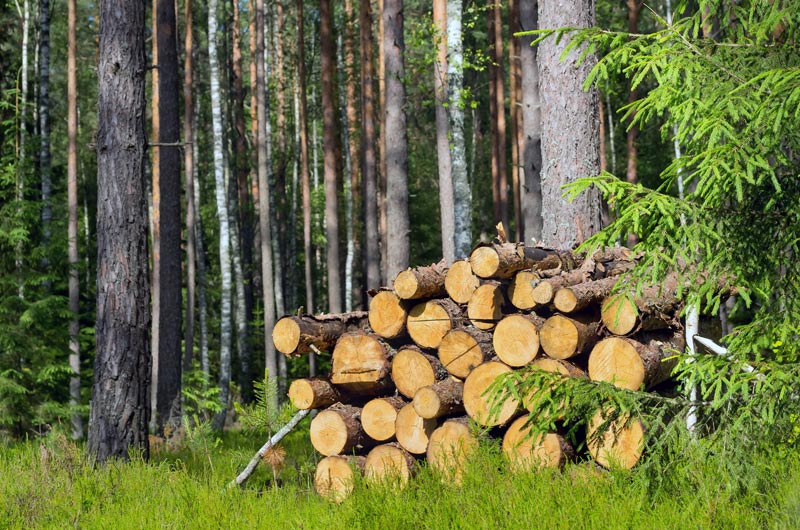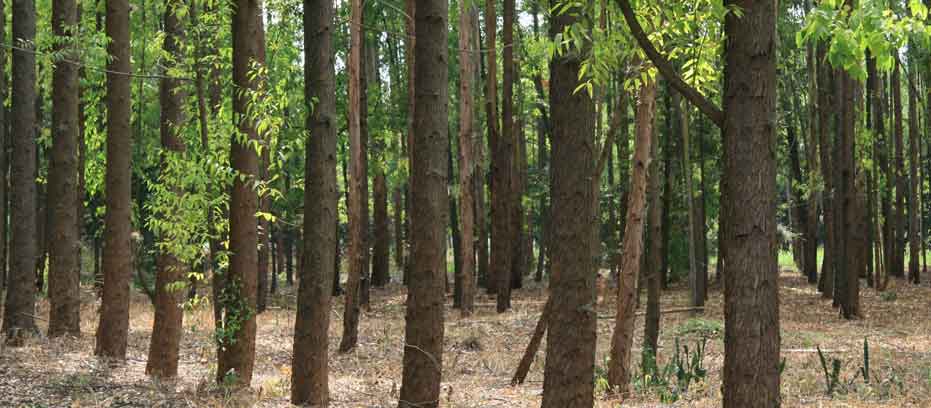Pine wood, a fast-growing softwood species, presents notable sustainability advantages over slow-growing hardwoods like oak.
With the ability to mature in as little as 20 years, pine forests can be sustainably managed, allowing for continuous growth and replacement.
This article explains why pine stands out as an eco-friendly, renewable, and versatile building material suitable for various applications.
Is Pine Wood Environmentally Friendly?

Pine wood can be an environmentally friendly option when sourced from reputable suppliers that use responsible forestry practices.
Pine is a fast-growing and renewable resource that is more sustainable than slow-growing hardwoods.
Look for pine certified by the FSC to ensure it comes from well-managed forests.
While no wood is perfect, pine is typically a good choice for those concerned about sustainability.
Key Points
- Pine is fast-growing and renewable, making it more sustainable than slow-growing woods.
- Pine wood is biodegradable and will break down to enrich soil.
- Look for FSC certification to ensure pine comes from responsible sources.
Our Opinion
In our opinion, pine can be an excellent environmentally friendly choice for wood projects.
Its rapid growth allows responsible harvesting and regeneration of forests.
While pine has some drawbacks like contributing to pollution, overall it remains one of the better options for sustainable forestry.
Is Pine Wood Sustainable?

When it comes to building materials, pine offers some clear sustainability advantages. This fast-growing softwood species can be replenished more quickly than slow-growing hardwoods like oak. In fact, pine takes as little as 20 years to reach maturity, while oak can take 80-120 years.
This means pine forests can be managed and trees harvested in a sustainable cycle that allows new growth to replace what is cut down. When properly managed, pine forests can receive certification from the Forest Stewardship Council (FSC) for responsible and sustainable forestry practices.
Studies have shown that wood in general has a lighter environmental footprint than alternatives like concrete or steel. Since pine grows rapidly, it’s considered a renewable and replaceable resource. This sets it apart from endangered rainforest hardwoods.
Pine tends to be less expensive than other woods, yet still offers beautiful grain patterns and strength properties that make it a great choice for furniture, flooring, and home building. Popular varieties like Southern Yellow Pine are valued for durability.
There are some concerns about pine trees releasing compounds that can contribute to air pollution. However, obtaining pine wood from FSC-certified sources provides assurance that the raw material was harvested sustainably.
Overall, pine is one of the more eco-friendly woods available today, especially when sourced responsibly. It’s a strong, renewable choice that makes sense for many applications.
How Does Pine Wood Compare to Other Woods?
Pine has some clear sustainability advantages over slower-growing hardwoods like oak or maple. Since pine reaches maturity faster, pine forests can be replenished more rapidly through sustainable forestry practices.
Pine also compares favorably to endangered tropical hardwoods that are harvested from old-growth rainforests. Using abundant softwoods like pine reduces pressure on these delicate ecosystems.
In terms of material properties, pine provides comparable strength to many hardwoods. Pine rates very well in stiffness, hardness, and shock resistance. It lags slightly behind oak in compression strength, but still rates as a durable wood.
While pine cannot match the richness and beauty of rare hardwoods, it provides an attractive grain and warm color tone. Pine is valued in furniture, flooring, and home building for both aesthetics and affordability.
Pine does have some drawbacks in terms of chemical compounds that can contribute to air pollution. However, responsibly sourced pine carries certifications to ensure sustainable harvesting practices are used.
Overall, abundant softwoods like pine make excellent alternatives to scarce tropical hardwoods. With responsible sourcing, pine offers sustainability combined with strength, beauty, and value.
What Are the Environmental Benefits of Pine Wood?

Pine offers a number of ecological advantages as a building material and renewable resource:
- As a fast-growing species, pine can be harvested and regrown rapidly compared to slow-growing hardwoods.
- Managed pine forests absorb CO2 from the atmosphere and can help mitigate climate change.
- Using abundant pine reduces pressure on endangered tropical rainforests.
- Pine has excellent thermal insulation properties, reducing energy consumption in buildings.
- Pine is biodegradable and recyclable at the end of its lifecycle.
- Pine can be sourced from FSC-certified forests to ensure sustainability.
While no material has zero environmental impact, responsibly sourced pine has a relatively small footprint. It strikes a balance between performance, beauty, and ecological benefits.
Compared to materials like steel, concrete, or plastics, pine is a renewable and recyclable choice for construction. As a fast-growing species, it can be replenished more rapidly than scarce tropical hardwoods.
With responsible forestry practices, pine offers a sustainable building material that is attractive, affordable, and ecologically friendly.
Is Pine Wood Furniture Eco-Friendly?
Yes, furniture made from pine can be an excellent eco-friendly choice compared to many other materials.
Pine is a renewable resource that can be replanted after harvesting. Managed pine forests even help absorb carbon from the atmosphere. This makes pine more sustainable than scarce tropical hardwoods.
Pine furniture also tends to use less energy and chemicals to produce than metal or plastic alternatives. It requires less processing compared to materials like particleboard.
At the end of its life, pine furniture can be recycled or will biodegrade. This gives it an advantage over composites or synthetic materials.
To ensure sustainability, look for pine furniture made from FSC-certified sources. This ensures responsible forestry practices. Domestic pine production also reduces transportation emissions.
While no material is perfect, pine furniture made locally from managed forests is a greener option. Compared to many other kinds of wood and man-made materials, responsibly sourced pine furniture offers an eco-friendly blend of beauty, durability, and sustainability.
Why Choose Pine Wood for Green Buildings?
Pine offers many benefits that make it an excellent green building material compared to other options.
As a renewable resource, pine wood can be replanted after harvesting. This gives it an advantage over slower-growing hardwoods or non-renewable materials.
Pine is also less energy-intensive to harvest and process than metal, concrete, or composites. The softer wood requires less energy to cut and shape.
Once in place, pine can help regulate indoor temperatures and humidity. The porous structure provides natural insulation and moisture control.
At the end of life, pine wood is biodegradable and can be reused or recycled. This gives it a sustainability edge over materials headed for landfills.
Opt for FSC-certified pine from local sources to ensure responsible harvesting. Domestic pine reduces transportation emissions.
With its warm look and natural properties, pine is an excellent choice for green homes and buildings. This renewable, recyclable, and energy-efficient material checks many boxes for sustainable design.
FAQ
Is Using Pine Wood Good for the Environment?
Pine wood can be a good option for the environment when sourced responsibly. Look for pine wood certified by the Forest Stewardship Council (FSC) to ensure sustainability.
What Is the Most Eco-Friendly Wood?
Fast-growing woods like pine, poplar, and bamboo are typically considered the most eco-friendly options. They can be harvested and regrown more sustainably than slow-growing hardwoods.
Is Pine Wood Biodegradable?
Yes, pine wood is biodegradable. As an organic material, it will break down over time and return nutrients to the soil.
What Is the Least Environmentally Friendly Wood?
Slow-growing tropical hardwoods like mahogany, teak, and rosewood are generally considered the least environmentally friendly. Their slow growth makes replacement difficult and contributes to deforestation.
Conclusion
When sourced responsibly from certified sustainable forests, pine wood can be an environmentally friendly choice. Pine is a fast-growing and renewable wood that is biodegradable. While no wood is perfect, pine compares favorably to alternatives in terms of sustainability. Overall, yes, pine wood can be an environmentally friendly option when properly managed.
